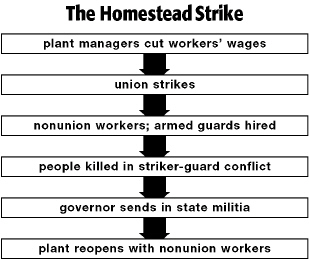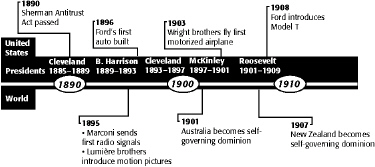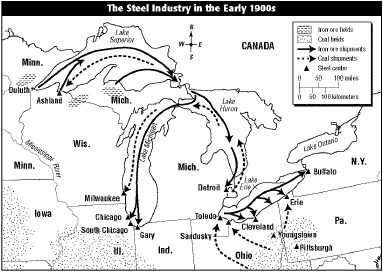Multiple Choice
Identify the
choice that best completes the statement or answers the question.
|
|
|
|
|
|
1.
|
 If the average work day was 12 hours per day,
and the work week was 6 days, how much would a machine woodworker earn in a week? a. | $15.00 | c. | $9.00 | b. | $30.00 | d. | $18.00 |
|
|
|
|
|
|
2.
|
 How did the Silver Mines Unrest end? a. | The miners won union recognition. | b. | Idaho jailed hundreds of striking
workers. | c. | Federal troops quelled riots. | d. | The Colorado militia burned the miners’
tent colony. |
|
|
|
3.
|
 Based on the information on the map, in which
years did landmark labor struggles take place in the State of Illinois? a. | 1877 & 1886 | c. | 1892 & 1902 | b. | 1886 & 1892 | d. | 1886 & 1894 |
|
|
|
4.
|
 According to the map, where did the Great
Railway Strike begin? a. | Scranton, PA | c. | Ludlow, CO | b. | Homestead, PA | d. | Martinsburg, WV |
|
|
|
5.
|
Railroad barons were created because the industry
a. | collated. | c. | consolidated. | b. | condensed. | d. | concentrated. |
|
|
|
|
|
|
6.
|
 Which railroad connected California and
Utah? a. | Atchison, Topeka and Santa Fe | c. | Central Pacific | b. | Northern
Pacific | d. | Union
Pacific |
|
|
|
7.
|
 Based on the information on the map, what
1870s innovation allowed meat and produce to be more efficiently transported by rail? a. | refrigerated cars | c. | passenger cars | b. | cow catchers | d. | diesel engines |
|
|
|
8.
|
 Based on the map, which railroad lines would
a traveler have to take to get from Kansas City, Missouri to Promontory Summit, Utah? a. | Atlantic and Pacific R.R. & Southern Pacific R.R. | b. | Northern Pacific
R.R. & Southern Pacific R.R. | c. | Kansas Pacific R.R. & Union Pacific
R.R. | d. | Central Pacific R.R. & Union Pacific R.R. |
|
|
|
9.
|
 | Which of the following innovations on the map was developed by Gustavus
Swift? | | |
a. | air brakes | b. | the refrigerated railroad
car | c. | lighter trains that took only 10 days coast to coast | d. | the transcontinental
route |
|
|
|
10.
|
Who pioneered the assembly line?
a. | Henry Ford | c. | Jan Matzeliger | b. | Thomas Edison | d. | Cyrus Field |
|
|
|
11.
|
Whose shoe-making machine performed many steps previously done by hand?
a. | Christopher Sholes | c. | John Thurman | b. | Jan E. Matzeliger | d. | Lewis H.
Latimer |
|
|
|
12.
|
Henry Ford introduced the Model T to the public in
a. | 1890. | c. | 1918. | b. | 1906. | d. | 1908. |
|
|
|
|
|
|
13.
|
 How many time zones are there in the 48
continental United States?
|
|
|
14.
|
 Based on the map, what time is it in Texas
when it is 4:00 P.M. in Alaska? a. | 3:00 P.M. | c. | 6:00 P.M. | b. | 5:00 P.M. | d. | 7:00 P.M. |
|
|
|
15.
|
Which the steel company owner was a great philanthropist?
a. | Cyrus Field | c. | Andrew Carnegie | b. | Granville Woods | d. | Gustavus Swift |
|
|
|
16.
|
In 1881 a group of national trade unions formed the
a. | American Federation of Labor. | b. | International Ladies' Garment Workers
Union. | c. | National Miners' Union. | d. | American Pullman's
Union. |
|
|
|
17.
|
Which legislation was a response to the public's growing concern over
trusts and monopolies?
a. | Trust and Monopolies Act | c. | Trust Act | b. | Sherman Antitrust
Act | d. | Monopolies
Act |
|
|
|
18.
|
The practice of combining separate companies in an industry is called a
a. | monopoly. | c. | philanthropy. | b. | consolidation. | d. | rebate. |
|
|
|
19.
|
Which inventor's most important invention was the electric
lightbulb?
a. | Granville Woods | c. | Henry Ford | b. | George Eastman | d. | Thomas Edison |
|
|
|
20.
|
People who invest in corporations by buying stock are called
a. | corporation bosses. | c. | bondholders. | b. | shareholders. | d. | stockers. |
|
|
|
21.
|
  Based on the flowchart,
which of the following did not lead to the governor sending the state militia in to deal with
the Homestead Strike? a. | plant managers cut workers’ wages | b. | plant reopens with
nonunion workers | c. | nonunion workers; armed guards hired | d. | union strikes |
|
|
|
22.
|
The fast-growing national rail system encouraged the expansion of the
a. | economy. | c. | electorate. | b. | patent system. | d. | Oregon Trail. |
|
|
|
23.
|
  Based on the time line, how
many terms did Theodore Roosevelt serve as United States president? a. | three | c. | one | b. | two | d. | none of the
above |
|
|
|
24.
|
  Based on the map, which of
the following statements is correct? a. | Indiana was rich in iron ore fields. | b. | Illinois was rich in iron ore
fields. | c. | Iron ore fields were south of coal fields. | d. | Iron ore fields were
north of coal fields. |
|
|
|
25.
|
What led to the creation of a multimillion-dollar petroleum industry?
a. | Edwin L. Drake's well | c. | air travel | b. | railroads | d. | electricity |
|
|
|
26.
|
Whose electric power plant lit up 85 buildings in New York City?
a. | Cyrus Field | c. | Henry Ford | b. | George Eastman | d. | Thomas Edison |
|
|
|
27.
|
The United States Attorney General Richard Olney ordered an injunction to stop
the
a. | Homestead Strike. | c. | Pullman Strike. | b. | Railroad Strike of 1877. | d. | Haymarket Riot. |
|
|
|
28.
|
Who invented the typewriter?
a. | Christopher Sholes | c. | William Burroughs | b. | Alexander Graham Bell | d. | Thomas Edison |
|
|
|
29.
|
Who invented the telephone?
a. | Alexander Graham Bell | c. | Cyrus Field | b. | George Westinghouse | d. | Thomas Edison |
|
|
|
30.
|
A tragic fire that broke out in the Triangle Shirtwaist Company factory led the
International Ladies' Garment Workers Union to push for
a. | shorter working hours. | c. | a safer working environment. | b. | higher
wages. | d. | hazard
pay. |
|
|
|
31.
|
Antilabor feeling grew after the bloody clash in Chicago called the
a. | Haymarket Riot. | c. | Pullman Strike. | b. | Railroad Strike of 1877. | d. | Homestead
Strike. |
|
|
|
32.
|
Thomas Edison's most important invention was the
a. | electric lightbulb. | c. | camera. | b. | vacuum cleaner. | d. | automatic circuit
breaker. |
|
|
|
33.
|
The growing railroad network paved the way for American industry to
a. | ship overseas. | c. | mass-produce. | b. | consolidate. | d. | expand into the
West. |
|
|
|
34.
|
Who was responsible for laying a telegraph cable across the Atlantic Ocean in
1866?
a. | John Thurman | c. | George Pullman | b. | George Westinghouse | d. | Cyrus Field |
|
|
|
35.
|
Who took Edison's work a step further by developing transformers?
a. | George Westinghouse | c. | Lewis Howard Latimer | b. | Granville Woods | d. | Elijah McCoy |
|
|
|
36.
|
Gaining almost total control of an industry is called
a. | horizontal integration. | c. | vertical
integration. | b. | a dividend. | d. | a monopoly. |
|
|
|
37.
|
The combining of companies is called
a. | dividends. | c. | mergers. | b. | corporations. | d. | shareholders. |
|
|
|
38.
|
Who was the steel industrialist who donated $350 million as a
philanthropist?
a. | John D. Rockefeller | c. | Andrew Carnegie | b. | J. Pierpont Morgan | d. | J. Edgar
Thompson |
|
|
|
39.
|
After consolidation of the railroads, who controlled the nation's rail
traffic?
a. | railroad noblemen | c. | railroad lords | b. | railroad barons | d. | railroad
aristocrats |
|
|
|
40.
|
Who introduced improved dining cars, raising train travel to a new level of
luxury?
a. | Gustavus Swift | c. | George M. Pullman | b. | George Westinghouse | d. | Eli H. Janney |
|
|
|
41.
|
The inventor of the railroad sleeping car was
a. | Eli H. Janney. | c. | George M. Pullman. | b. | Henry Ford. | d. | Gustavus Swift. |
|
|
|
42.
|
Who was the philanthropist who built more than 2,000 libraries worldwide?
a. | Andrew Carnegie | c. | George Westinghouse | b. | Henry Ford | d. | John D.
Rockefeller |
|
|
|
43.
|
Who was responsible for creating the assembly line?
a. | Granville Woods | c. | Charles Sorenson | b. | Henry Ford | d. | George
Westinghouse |
|
|
|
44.
|
Who linked the United States and Europe with a transatlantic telegraph
line?
a. | George Eastman | c. | Edwin L. Drake | b. | Thomas Edison | d. | Cyrus Field |
|
|
|
45.
|
By the late 1880s, almost all railroad companies had adopted
a. | five time zones. | c. | air brakes. | b. | iron tracks. | d. | a standard
gauge. |
|
|
|
46.
|
The combining of competing firms into one corporation is called
a. | vertical integration. | c. | a corporation. | b. | a dividend. | d. | horizontal
integration. |
|
|
|
47.
|
The steelworkers' union dwindled after the failure of the
a. | Homestead Strike. | c. | Pullman Strike. | b. | Haymarket Strike. | d. | Railroad Strike of
1877. |
|
|
|
48.
|
Originally, railroad tracks were made of
a. | steel. | c. | copper. | b. | iron. | d. | zinc. |
|
|
|
49.
|
Child-labor laws were passed for children working in
a. | factories. | c. | mining. | b. | agriculture. | d. | retail. |
|
|
|
50.
|
When unions represent workers in talking to management, it is called
a. | collective bargaining. | c. | strikebreaking. | b. | injunctions. | d. | strikes. |
|